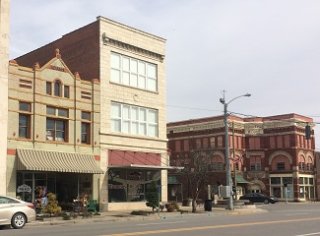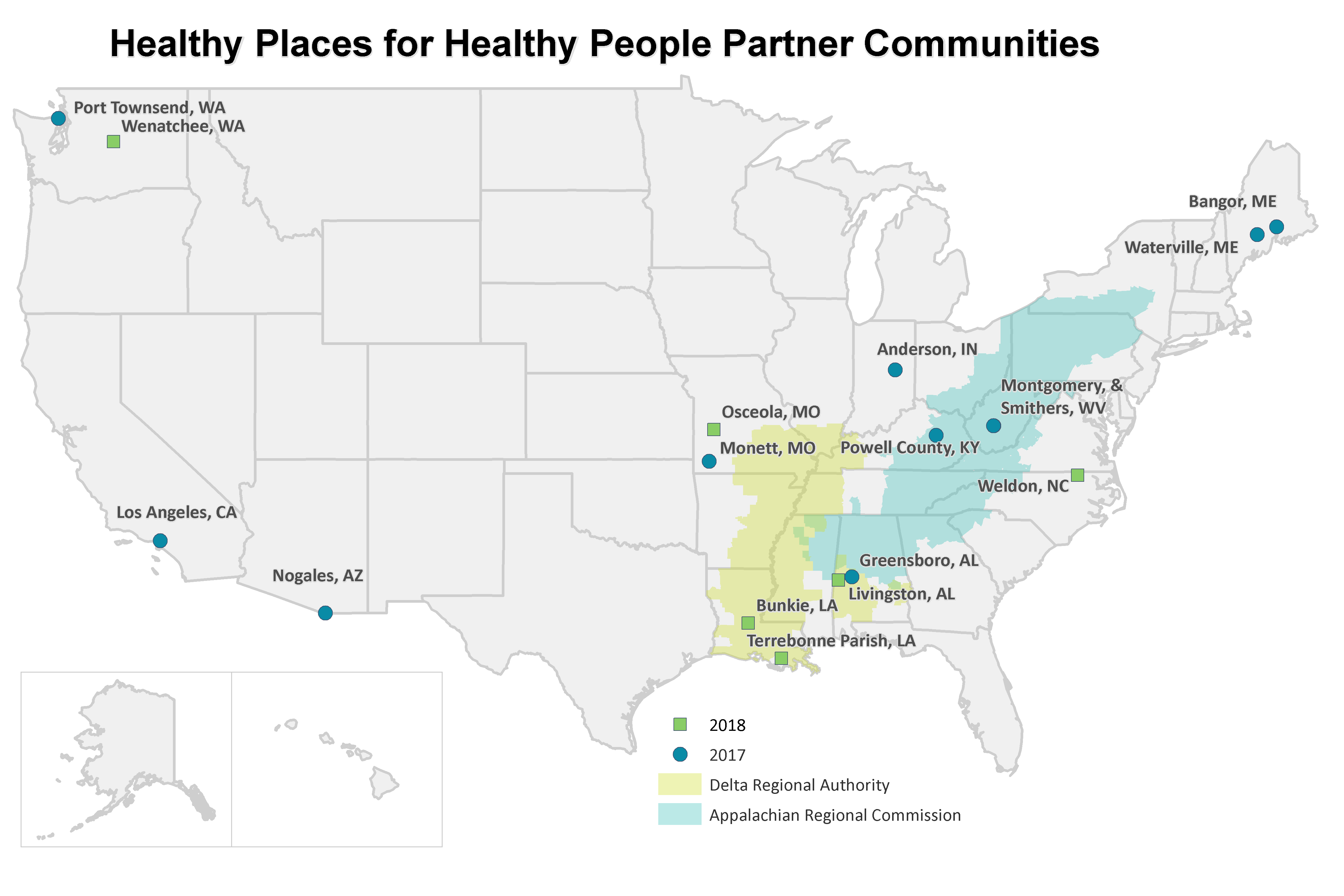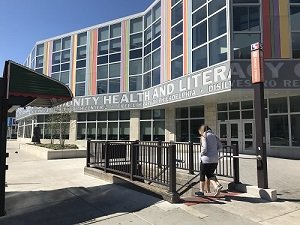Healthy Places for Healthy People
On other pages:
- Frequently Asked Questions About Healthy Places for Healthy People
- Smart Growth Technical Assistance: Learn more about the Office of Community Revitalization's current and past planning assistance programs.
Background

Healthy Places for Healthy People was a planning assistance program that engaged community leaders and health care partners to collaborate to create walkable, healthy, economically vibrant downtowns and neighborhoods that improved health, protected the environment and supported economic growth. These partners included community health centers (including Federally Qualified Health Centers), nonprofit hospitals and other health care facilities.
Health care facilities can be particularly helpful partners in rural communities and small towns, where their economic impact can be especially important. These facilities can catalyze downtown revitalization and promote health, environmental and economic goals by:
- Locating health centers, hospital facilities, and associated programs in walkable, compact neighborhoods and central business districts that are accessible via a range of transportation options.
- Supporting local entrepreneurs who have business ideas that will contribute to a healthy community and create economic opportunities for residents.
- Working with partners and stakeholders in various sectors to use health as an economic driver for a local, thriving economy and a healthy community.
- Fostering collaboration between workforce development and economic development initiatives to renovate and repurpose abandoned downtown buildings into new health center sites, affordable housing, retail, and other community assets.
- Providing primary care and preventive services to those who do not have access to care.
- Promoting healthy behaviors and lifestyles through activities such as supporting downtown farmers markets, co-op markets, and community gardens that provide access to fresh, healthy, local food.
- Creating physical activity programs and supporting sidewalks, bike paths, trails, and parks in the community that promote active living.
2018 Partner Communities

EPA worked with six communities in 2018 in partnership with the U.S. Department of Health and Human Services — Health Resources and Services Administration and the Delta Regional Authority.
- Bunkie, Louisiana: The city of Bunkie, Move Bunkie Forward, and Bunkie General Hospital aimed to integrate Main Street revitalization strategies with health improvement efforts, seeking greater economic stability and improved human health.
- Terrebonne Parish, Louisiana: The Isle de Jean Charles Biloxi-Chitimacha-Choctaw Tribe was relocating to a new community in Schriever, Louisiana, after being displaced from an area that experienced coastal land loss. The workshop helped them visualize an environmentally friendly design with access to physical activity, healthy food, and health care.
- Livingston, Alabama: The city of Livingston and the University of West Alabama collaborated to develop health and wellness initiatives in downtown Livingston, the Sumter County seat, to improve access to health care and healthy food, provide economic development opportunities, and support downtown revitalization efforts. Watch a video about their journey.
- Osceola, Missouri: The West Central Missouri Community Action Agency, the city of Osceola, the Osceola Optimist Club, Osceola Schools, and the St. Clair County Economic Development office worked with two hospitals that have invested in health clinics in Osceola to plan for new sidewalks, trails, and housing to serve an aging population. This work tied health into broader economic development efforts that took advantage of the area’s natural assets to boost tourism and the economy.
- Weldon, North Carolina: The town of Weldon, Halifax Community College, and the Roanoke Valley Community Health Initiative partnered to improve health care access and walkability downtown with the goal of improving economic, environmental, and community health.
- Wenatchee, Washington: The Trust for Public Land, the city of Wenatchee, Confluence Health, Community Choice, and neighborhood residents aimed to revitalize a park in South Wenatchee. The goal was to connect the park to downtown, support health-focused entrepreneurs, and help the community embed economic development considerations into efforts to improve the mental, physical, and environmental health for all residents.
2017 Partner Communities
EPA partnered with ten communities during the pilot phase of Healthy Places for Healthy People:
- Anderson, Indiana: The Madison County Council of Governments, the city of Anderson, and several local hospital and health center partners developed a plan to create Health Districts throughout the city around key health care facilities to help revitalize the neighborhoods, improve the environment, and contribute to health improvements for residents.
- Bangor, Maine: The city of Bangor, Eastern Maine Healthcare Systems, Acadia Hospital, Penobscot Community Health Care (a Federally Qualified Health Center), and other partners worked to integrate public and environmental health initiatives with downtown revitalization strategies, including creating more transportation opportunities and promoting business development downtown.
- Greensboro, Alabama: The city of Greensboro partnered with the West Central Alabama Area Health Education Center, Hale County Hospital, Whatley Health Services (a Federally Qualified Health Center), Project Horseshoe Farm, Hale Empowerment and Revitalization Organization, and others to revitalize Greensboro’s downtown corridor while enhancing the community's environmental and economic health.
- Los Angeles, California: The nonprofit New Economics for Women partnered with the nonprofit public charter school NEW Academy of Science and Arts and the Arroyo Vista Family Health Center (a Federally Qualified Health Center), each based in the Pico-Union/Westlake neighborhood, to address blight, air quality, and poverty, while also meeting the housing and health care needs of the primarily immigrant community it served.

Putting health centers in buildings with a mix of community and civic services and that are easily accessible by foot, bike, transit, or car makes it easier for residents to get the services they need.
Photo courtesy of Mike Callahan, Renaissance Planning. - Montgomery and Smithers, West Virginia: Fayette County partnered with Montgomery General Hospital and New River Health Association (a Federally Qualified Health Center that ran a school-based health clinic) to identify ways that the health and wellness sector can reinvigorate the regional economy and contribute to cleaning up blighted properties downtown.
- Monett, Missouri: The local hospital, CoxHealth, worked with the city of Monett, the local school district, the Monett Main Street Organization, and other partners to improve health and the environment in the downtown and surrounding neighborhoods by building opportunities for walking and physical exercise, improving access to healthy food, and creating downtown revitalization strategies.
- Nogales, Arizona: Mariposa Community Health Center (a Federally Qualified Health Center) explored creating a downtown clinic location. As the health center incorporated health and wellness into its plans, it envisioned green and open spaces for walking and physical activity and more economic opportunities for new businesses to start downtown.
- Port Townsend, Washington: The North Olympic Peninsula Resource Conservation and Development Council, Jefferson Healthcare, and the city of Port Townsend partnered with community organizations to repurpose a former school into an integrated center to house health care, social services, community wellness, and strengthened emergency preparedness.
- Powell County, Kentucky: The Kentucky River Foothills Development Council, which operated a Federally Qualified Health Center, and its partners worked together on the "Healthy Powell County" effort to create walking trails, community gardens, and transportation options to improve health, economic, and environmental outcomes in communities throughout the county.
- Waterville, Maine: Healthy Northern Kennebec, a coalition supported by MaineGeneral Health, partnered with Inland Hospital, Colby College, and other partners through the "Healthy Waterville" initiative to revitalize downtown Waterville while ensuring all residents have access to healthy food, health care, and economic opportunity.
